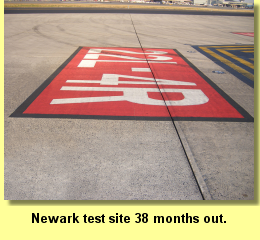 |
 |
AirMarkBy Mike SpeidelThe FAA recently sent out a change to the FAA AC 150/5370-10E specification. Within item P-620, preformed thermoplastic has been added as an approved marking product on airfields as of September 30th, 2009. I spent the last week at Flint Trading, Inc. based in Thomasville, NC, training to become a certified applicator for their airport-specific product with the suitable name, AirMark. Durable markings such as epoxy, methacrylate, and thermoplastic have not traditionally been used on airport surfaces in the past. However, this is not your father's thermoplastic. AirMark is a 65 mil (about 1/16") durable, retroflective marking material suitable for use on taxiways, aprons, and roadway delineation and markings. The markings are custom made to each airport's specific requirements. Certain standard linear markings are in stock and available for immediate shipment. AirMark has glass beads intermixed within the product to ensure proper retroreflective characteristics throughout its life cycle. Unlike other durables, AirMark is designed to expose new glass beads as the thermoplastic wears over time. The ease of application relative to waterborne paint is a benefit. Installation requires layout, surface preparation, applying a specially designed sealant, placement and subsequent heating of the material, and finally bond tests for quality assurance. The heating equipment includes the AutoIR816 infrared heater with the ability to heat up to 16 feet wide in one pass, as well as hand-held torches for touch-up work, as necessary. The application process takes approximately 40 minutes for a 13' x 23' sign with a 4-person crew; one of the crew must be a card-carrying master certified applicator.
After one year, the AirMark still produced retroreflective readings of 193 mcd/m A marking's durability depends on its color retention as well. The current federal TT-P-1952E waterborne paint specification does not have any UV inhibitors included in the formulation. That fact is commonly demonstrated as the organic pigments in waterborne yellows, reds, and blacks are slowly destroyed by ultraviolet light from the sun, resulting in color fading. AirMark, unlike current specified waterborne paints, includes UV inhibitors to resist color fading which adds to longer functional marking life. AirMark was designed specifically for use on airfields, which is welcomed in an industry where highway marking technology and philosophy prevail. You can see an installation of AirMark at one of Sightline's Airfield Marking Symposiums in 2010 (host airports receive one installed gratis), or can watch Flint's video online at their website: www.flinttrading.com. |

 In August of 2006, Newark Liberty International Airport was the first FAA test site for an AirMark surface painted hold
position sign on one of its busiest taxiways leading to runway 22L-4R. An AirMark sign and a waterborne painted sign were applied side
by side to directly compare the life cycles of the two materials for one year. 9 months into the test comparison the white waterborne
paint demonstrated ineffective retroreflective levels and was repainted... perhaps Sightline could have assisted in application!
In August of 2006, Newark Liberty International Airport was the first FAA test site for an AirMark surface painted hold
position sign on one of its busiest taxiways leading to runway 22L-4R. An AirMark sign and a waterborne painted sign were applied side
by side to directly compare the life cycles of the two materials for one year. 9 months into the test comparison the white waterborne
paint demonstrated ineffective retroreflective levels and was repainted... perhaps Sightline could have assisted in application!